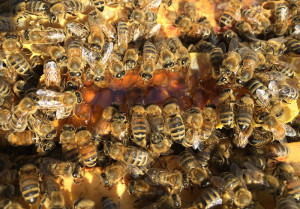Hive Inspection Checklist

When you inspect your hives, you should record the hive numbers to keep track of which hives you’ve inspected. This will help keep track of your progress. Before you begin, observe the bees’ entrance and see if there is lots of activity. If you see many bees coming and going, it’s usually an indicator that the hive is strong. If you see few to no bees at the entrance, this may be reason for a concern.
Be sure to check your weakest hives more frequently if you plan on ‘doctoring’ them back to health. The weakest hives are more prone to disease and pest issues that you do not want. Your strong hives are strong because they are healthy and thriving.
During a routine hive inspection you want to check for the following items:
- Is the hive queenright: Look for the queen. If you have marked her, keep that in mind. If you cannot find the queen, look for eggs. Since eggs hatch in 3 days, you assume the queen was there 3 days ago. Sometimes queens are very hard to locate. I always try to find the queen but it’s not necessary. If you do find an unmarked queen, your old queen may have either swarmed or superceded. See point two.
- Look for swarm cells or supercedure cells: If you see swarm or supercedure cells, you need to make a decision to keep or remove them. If they are swarm cells, you may want to remove the frames and let the queen hatch out in a mating nuc or queen castle. If you find supercedure cells, I recommend leaving them alone because usually bees know what they are doing and don’t require human intervention. Either way, you need to make a decision based on the overall hive appearance. Sometimes you may be too late and find a marked queen missing but find hatch and destroyed cells; a clear indicator you have a new queen.
-

When you crack open a hive, you open up cells of honey stored between frames. Check the amount/condition of brood: This will depend on the time of year. In Manitoba, I want to see 4 frames of brood in mid spring at least and 8 frames of bees is preferable. During summer, you may have 8-10 frames brood in mid-summer. This is something you will understand with more experience. You want to see if the queen is active and laying.
Check the condition of the brood; is it nice and white and properly fed? What’s the laying pattern like? Although we don’t necessarily go looking for foulbrood or chalkbrood, you need to keep it in mind in case you come across it. We have never had issues with foulbrood, but if discovered, you need to use ‘brute force’ methods and eliminate it ASAP. This usually means eliminating all equipment and bees that are exposed to this disease.
Chalkbrood is usually is an indicator the hive is stressed and you need to determine the cause. If it’s caused by stress, adding additional brood and feed/pollen might help. Or it might be the queen; sometimes overwintered queens are more susceptible to this or her genetics may be connected. We often requeen chalkbrood hives.
- Check pollen and honey stores: Depending on the time of year, this may be a concern. In spring, your bees may require supplement food and pollen.
- Check drone brood: When you do an inspection, you will inadvertently open cells containing developing drone larvae in them. It happens when the queen lays eggs close to the top or in between honey supers. Check the drone brood to see if there is varroa on the larvae. This is a simple way to check if you have varroa issues.
- Overall bee population: Make a note if the hive is healthy and the amount of bees is sufficient. If the hive has low bees population, the queen may be slowing down. However, the queen may have reduced laying because of the low population. I’ve seen this in nucs and this can be remedied by giving the hive a brood bomb. If the queen is failing, she needs to be replaced.
- Check for pests like wax moth: I don’t necessarily go looking for these but always keep it in the back of my mind. Weaker hives are more susceptible to pest problems. Keep strong hives and most pest issues are remedied.
When we inspect hives, we don’t use checklists. They are just points you will naturally learn to cover as you inspect your hives. A better idea is to make note of hives that have problems not the hives that are performing great.
Queen finding tip: It’s nice to find the queen and you’ll usually have a rough idea where she is by observing the laying pattern. I often find the queen close to the frames with eggs on them. As you inspect the frames, keep track where most of the eggs are located. She is usually in that area. However, this is not always the case. If your queen is marked, she will much easier to find.